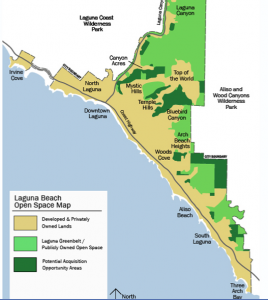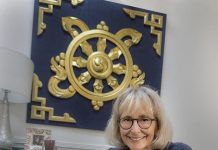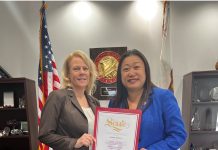
Supporters of an open space initiative believe they have collected more than enough signatures to qualify the measure for the next scheduled election, a consultant said this week.
Citizens for Preservation of Open Space expect by next month to turn into the city clerk the signatures collected by volunteers beginning in April, said campaign consultant Paul Freeman, a former city council member. Initiative supporters have had six months to collect signatures from 15 percent of the town’s registered voters, or 2,700 people, in order to qualify the measure for the next upcoming election in June 2012.
The measure would ask Laguna Beach voters to again tax themselves $20 million over the next two decades to purchase 550 acres that could potentially be developed. The non-contiguous parcels are in 16 different areas within city limits, but generally near existing open space or wilderness areas.
In 1990, 80 percent of Laguna voters approved a similar initiative, agreeing to tax themselves for a $20 million bond measure to save Laguna Canyon from development. Those bonds pay off this year.
Without a visible development threat, however, the current proposal met with skepticism. “What we don’t know is which parcels of land will be purchased and for how much?” Jill Cooper asked in a letter to the Indy, published in the May 13 edition. “If a property owner or group of neighbors don’t want a lot developed on their street, let them buy the lot and share in the expense of turning it into a park or trail. Let them pay for the yearly weed clearing or improvements,” she wrote.
Advocates initially refused to identify target properties, but are now trying to quell critics with a public website (lagunaopenspace.com), which displays a map that identifies potential open-space purchases. “It clearly calls out where the opportunities are,” said Freeman.
Open-space advocates were initially reluctant to pinpoint the properties out of courtesy to the owners, he said. “We didn’t want to put a spotlight on them,” Freeman said. “This map I hope goes far enough to satisfy the understandable questions we’ve been getting.”
The new proposal, which would require approval by two-thirds of those voting, would add a $120 annual tax to each parcel for the next 20 years, filling a $1 million a year kitty for open space purchases. The city’s own open space fund lacks a dedicated funding source and is nearly empty. Nothing was budgeted for this year.
Open-space advocates conducted a telephone poll among 400 residents last March, 90 percent of whom said they would vote for the 1990 measure again.
The proposed flat-tax initiative differs from the previous bond measure, which imposed differing tax assessments based on property value. The initiative’s language also specifically prohibits eminent domain seizures, thus limiting deal-making to willing sellers. Authority for making acquisitions would rest with elected officials, who are also required to appoint a watch-dog committee that would issue an annual report on the use of tax funds.
For the first time, the measure also requires the city to set aside 4 percent of the assessment for open-space maintenance.




